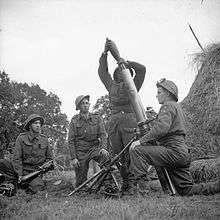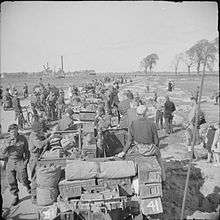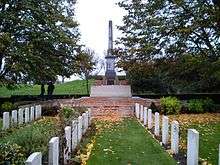49th (West Riding) Infantry Division
| West Riding Division 49th (West Riding) Division 49th (West Riding) Infantry Division 49th (West Riding) Armoured Division 49th (West Riding and Midland) Infantry Division | |
|---|---|
|
Second pattern, replaced the first pattern in late World War II | |
| Active |
1908–1919 1920-1945 1947-1967 |
| Country |
|
| Branch |
|
| Type |
Infantry Armoured from 1947 |
| Size | Division |
| Nickname(s) |
The Polar Bears (World War II) Barker's Bears (World War II) |
| Engagements |
First World War Second World War |
| Battle honours |
Somme (1916) Normandy The Odon Scheldt |
| Commanders | |
| Notable commanders |
Evelyn Barker Gordon Holmes MacMillan |
| Insignia | |
| Identification symbol |
_Division_insignia.png) World War I |
| Identification symbol |
World War II first pattern[1][lower-alpha 1] |
The 49th (West Riding) Infantry Division was an infantry division of the British Army. The division was formed in the Territorial Force on 1 April 1908 as the West Riding Division. The division fought in the Great War in the trenches of the Western Front, in the fields of France and Flanders. During World War II the division fought in the Norwegian Campaign and in North-western Europe. After the Second World War it was disbanded in 1946, then reformed in 1947. It remained with the Northern Command until finally disbanded in 1967.
First World War
The division was originally raised as the West Riding Division when the Territorial Force was created in 1908. In 1915, during the Great War, it was designated the 49th (West Riding) Division and given the White Rose of York as its insignia.
Formation 1914–1918
- 1/5th Battalion, Prince of Wales's Own (West Yorkshire Regiment)
- 1/6th Battalion, Prince of Wales's Own (West Yorkshire Regiment)
- 1/7th (Leeds Rifles) Battalion, Prince of Wales's Own (West Yorkshire Regiment)
- 1/8th (Leeds Rifles) Battalion, Prince of Wales's Own (West Yorkshire Regiment) (until January 1918)
- 146th Machine Gun Company, Machine Gun Corps (from 27 January 1916, moved to 49th Battalion, Machine Gun Corps 1 March 1918)
- 146th Trench Mortar Battery (from 12 June 1916)
- 1/4th Battalion, Duke of Wellington's (West Riding Regiment)
- 1/5th Battalion, Duke of Wellington's (West Riding Regiment) (until January 1918)
- 1/6th Battalion, Duke of Wellington's (West Riding Regiment)
- 1/7th Battalion, Duke of Wellington's (West Riding Regiment)
- 147th Machine Gun Company, Machine Gun Corps (from 26 January 1916, moved to 49th Battalion, Machine Gun Corps 1 March 1918)
- 147th Trench Mortar Battery (from 12 June 1916)
- 1/4th Battalion, King's Own (Yorkshire Light Infantry)
- 1/5th Battalion, King's Own (Yorkshire Light Infantry) (until February 1918)
- 1/4th (Hallamshire) Battalion, York and Lancaster Regiment
- 1/5th Battalion, York and Lancaster Regiment
- 148th Machine Gun Company, Machine Gun Corps (from 6 February 1916, moved to 49th Battalion, Machine Gun Corps 1 March 1918)
- 148th Trench Mortar Battery (from 12 June 1916)
- Pioneers
- 1/3rd Battalion, Monmouthshire Regiment (from April 1915 to August 1916)
- 19th (Service) Battalion (3rd Salford Pals), Lancashire Fusiliers (from August 1916)
Second World War



During World War II, the 49th Division first saw action beginning on 15–17 April 1940 when two of its brigades took part in the short and ill-fated landings in Norway that were intended to retake the ports of Trondheim and Narvik from the German Army. The campaign was a complete disaster and the division withdrew from Norway in May 1940.
The division's 146th and 147th Infantry Brigades were thereafter stationed in Iceland and the 148th Infantry Brigade became a training brigade and was no longer a part of the division.[3] As a result, a new divisional insignia, featuring a polar bear standing on an ice floe, was adopted. The idea was from the divisional commander, Major General Evelyn Barker. In 1942, the division was transferred back to the United Kingdom where the 70th Brigade, from the disbanded 23rd Division, was assigned to the 49th Division.
Just after D-Day, in June 1944, the 49th Division moved to France as part of XXX Corps. During the fierce fighting in Normandy, the Nazi propaganda broadcaster Lord Haw-Haw referred to the division as "the Polar Bear Butchers". In late September 1944 the division was awarded its first and only Victoria Cross of the Second World War, belonging to Corporal John William Harper of the Hallamshire Battalion, York and Lancaster Regiment. In October 1944 the 70th Brigade was disbanded due to a shortage of trained infantrymen in the British Army and the 56th Independent Infantry Brigade was assigned to the division, remaining with it for the rest of the war. During the rest of the war, the division served mainly with the First Canadian Army and was variously under the command of I Corps, the II Canadian Corps, and the I Canadian Corps. The 49th Division's last major contribution to the Second World War was the Second Battle of Arnhem and the fierce battles that led to it.
Just after the German surrender on 7th May 1945 the division played a part in the liberation of Utrecht with the 49th Reconnaissance Regiment entering first followed by Canadian troops. There’s a monument dedicated to the Polar Bears at a spot on Biltstraat in the city. During the course of the war the division suffered heavy casualties of 11,000 wounded or missing in action with around 1,642 killed in action.
Order of battle Second World War
The 49th Infantry Division was constituted as follows during the war:[4]
- 4th Battalion, Lincolnshire Regiment
- 1/4th Battalion, King's Own Yorkshire Light Infantry
- Hallamshire Battalion, York and Lancaster Regiment
- 1/5th Battalion, West Yorkshire Regiment (left 7 September 1942)
- 1/6th Battalion, Duke of Wellington's Regiment (West Riding) (disbanded and merged into 1/7th Battalion on 17 August 1944, due to heavy losses during Operation Martlet)
- 1/7th Battalion, Duke of Wellington's Regiment (West Riding)
- 147th Infantry Brigade Anti-Tank Company (formed 20 March 1940, disbanded 1 August 1941)
- 11th Battalion, Royal Scots Fusiliers (from 8 September 1942, replacing 1/5th West Yorkshire Regiment)
- 1st Battalion, Leicestershire Regiment (from 6 July 1944, replacing 1/6th Duke of Wellington's Regiment (West Riding))
148th Infantry Brigade (left June 1940)[6]
- 1/5th Battalion, Leicestershire Regiment
- 1/5th Battalion, Sherwood Foresters (until December 1939)
- 8th Battalion, Sherwood Foresters
- 2nd Battalion, South Wales Borderers (from 18 December 1939)
70th Infantry Brigade (from 18 May 1942, disbanded 20 August 1944)[7]
- 10th Battalion, Durham Light Infantry
- 11th Battalion, Durham Light Infantry
- 1st Battalion, Tyneside Scottish (Black Watch (Royal Highland Regiment))
56th Infantry Brigade (from 20 August 1944)[8]
- 2nd Battalion, South Wales Borderers (left 27 April 1945, rejoined 14 June 1945)
- 2nd Battalion, Gloucestershire Regiment
- 2nd Battalion, Essex Regiment
- 7th Battalion, Royal Welch Fusiliers (from 28 April 1945, left 13 June 1945)
Divisional Troops
- 2nd Battalion, Princess Louise's Kensington Regiment (from 7 June 1943, joined as Divisional Support Battalion, became Machine Gun Battalion 28 February 1944)
- 49th Reconnaissance Regiment, Reconnaissance Corps (formed 5 September 1942, became 49th Reconnaissance Regiment, Royal Armoured Corps 1 January 1944)
- 69th (West Riding) Field Regiment, Royal Artillery
- 70th (West Riding) Field Regiment, Royal Artillery (until 6 August 1940)
- 71st (West Riding) Field Regiment, Royal Artillery (until 6 August 1940)
- 79th Field Regiment, Royal Artillery (from 8 until 23 June 1940)
- 80th Field Regiment, Royal Artillery (from 8 until 23 June 1940)
- 143rd (Kent Yeomanry) Field Regiment, Royal Artillery (from 26 April 1942)
- 178th Field Regiment, Royal Artillery (from 15 May 1942)
- 185th Field Regiment, Royal Artillery (from 24 December 1942, disbanded 29 November 1944)
- 74th Field Regiment, Royal Artillery (from 30 November 1944)
- 58th (Duke of Wellington's) Anti-Tank Regiment, Royal Artillery (until 23 June 1940)
- 88th Anti-Tank Regiment, Royal Artillery (from 17 June 1942 until 24 July 1943)
- 55th (Suffolk Yeomanry) Anti-Tank Regiment, Royal Artillery (from 26 July 1943)
- 118th Light Anti-Aircraft Regiment, Royal Artillery (from 5 July until 8 December 1942)
- 89th Light Anti-Aircraft Regiment, Royal Artillery (from 29 December 1942)
- 228th (West Riding) Field Company, Royal Engineers (until 30 September 1939)
- 229th (West Riding) Field Company, Royal Engineers (until 4 April 1940)
- 230th (West Riding) Field Company, Royal Engineers (until 4 April 1940)
- 294th Field Company, Royal Engineers (from 26 April 1942)
- 756th Field Company, Royal Engineers (from 26 April 1942)
- 757th Field Company, Royal Engineers (from 26 April 1942)
- 231st (West Riding) Field Park Company, Royal Engineers (until 4 April 1940)
- 289th Field Park Company, Royal Engineers (from 26 April 1942)
- 23rd Bridging Platoon, Royal Engineers (from 1 November 1943)
- 49th (West Riding) Divisional Signals Regiment, Royal Corps of Signals
Post 1945
The division was disbanded in Germany in 1946, but reformed in the Territorial Army in 1947, having been renamed the 49th (West Riding) Armoured Division. It was based in Nottingham, consisting of (on 1 April 1947):
- 8 (Yorkshire) Armoured Brigade
- 146 (West Riding) Infantry Brigade
- 147 (Midland) Lorried Infantry Brigade
- Artillery included 269 and 270 Field Regiments Royal Artillery
In 1956, it was renamed the 49th (West Riding and Midland) Infantry Division, its base moved to Leeds, and the 8th Armoured Brigade was removed from its order of battle. Finally, it underwent its last major change in 1961, when it was renamed to the 49th (West Riding and North Midland) Division/District, and the 147th Infantry Brigade was removed from its composition. The Division/District finally disbanded in 1967, becoming simply X District.[9]
The polar bear flash was last worn by 49th Brigade, Under Army 2020, 49 (E) Brigade was merged with 7th Armoured Brigade to become 7th Infantry Brigade on 13 February 2015.[10]
Commanders
- Brigadier-General Archibald J.A. Wright: April 1908 – January 1910
- Lieutenant-General George M. Bullock: January 1910 – September 1911
- Major-General Thomas S. Baldock: September 1911 – July 1915
- Major-General Edward M. Perceval: July 1915 – October 1917
- Major-General Neville J.G. Cameron: October 1917 – June 1919
- Major-General Henry R. Davies: June 1919 – June 1923
- Major-General Alfred A. Kennedy: June 1923 – March 1926
- Major-General Neville J.G. Cameron: June 1926 – June 1930
- Major-General Sir Reginald S. May: June 1930 – September 1931
- Major-General George H.N. Jackson: September 1931 – September 1935
- Major-General George C. Kelly: September 1935 – April 1938
Dates in British form (dd.mm.yyyy) indicating the date they entered the command (or resumed command when there are multiple dates).
- Maj. Gen. Pierse J. Macksey – 03.09.1939
- Maj. Gen. Harry O. Curtis – 10.06.1940
- Brig. Neville P. Procter – 12.04.1943 (Acting)
- Maj. Gen. Sir Evelyn W. Barker – 12.04.1943
- Maj. Gen. Sir Gordon H.A. MacMillan – 30.11.1944, 06.02.1945
- Brig. R.H. Senior – 27.01.1945 & 24.03.1945 (Acting)
- Maj. Gen. Stuart B. Rawlins – 28.03.1945, 27.04.1945
- Brig. Edward N. Crosse – 18.04.1945 (Acting)
- Brig. H. Wood – 23.08.1945 (Acting)
- Major-General E. Temple L. Gurdon: September 1945 – October 1946
- Major-General George W. Richards: January 1947 – December 1948
- Major-General Ronald B.B.B. Cooke: December 1948 – December 1951
- Major-General Reginald P. Harding: December 1951 – December 1954
- Major-General Ralph Younger: December 1954 – December 1957
- Major-General Richard E. Goodwin: December 1957 – July 1960
Memorial

At the Site John McCrae just outside Ypres there is a memorial to the 49th (West Riding) Infantry Division. It is located is immediately behind Essex Farm Commonwealth War Graves Commission Cemetery, on top of the canal bank.[11] It is shaped like an obelisk and accessed via a flight of stairs leading up the canal bank from the cemetery.
Recipients of the Victoria Cross
- Corporal Samuel Meekosha, 1/6th Battalion, West Yorkshire Regiment, Great War
- Corporal George Sanders, 1/7th (Leeds Rifles) Battalion, West Yorkshire Regiment, Great War
- Private Arthur Poulter, 1/4th Battalion, Duke of Wellington's (West Riding Regiment), Great War
- Corporal John William Harper, Hallamshire Battalion, York and Lancaster, Second World War
See also
- List of British divisions in World War I
- List of British divisions in World War II
- British Army Order of Battle (September 1939)
- Berenkuil (traffic), a type of traffic circle that may have been named after the division
- 46th Infantry Division 2nd Line duplicate during World War II
Notes
References
- ↑ Cole p. 44
- ↑ Delaforce p. 21
- ↑ "John Crook's service in Iceland".
- ↑ Joslen, pp. 79-80.
- ↑ Joslen, p. 331.
- 1 2 Joslen, p. 332.
- ↑ Joslen, p. 301.
- ↑ Joslen, p. 296.
- ↑ https://www.army.mod.uk/structure/History.aspx, accessed August 2012.
- ↑ "49 (East) Brigade Officially Disbanded". Forces TV. Retrieved 2 May 2015.
- ↑ CWGC: Essex Farm Cemetery, access date 2015-05-12
Bibliography
- Cole, Howark (1973). Formation Badges of World War 2. Britain, Commonwealth and Empire. London: Arms and Armour Press.
- Delaforce, Patrick (1995). The Polar Bears: Monty's Left Flank: From Normandy to the Relief of Holland with the 49th Division. Stroud: Chancellor Press. ISBN 9780753702659.
- Lt-Col H.F. Joslen, Orders of Battle, United Kingdom and Colonial Formations and Units in the Second World War, 1939–1945, London: HM Stationery Office, 1960/Uckfield: Naval & Military, 2003, ISBN 1-84342-474-6.
External links
- The British Army in the Great War: The 49th (West Riding) Division
- Regiments.org Summary and Lineage
- Composition of the 49th Division
- Generals of World War II
- 49th (West Riding) Infantry Division Polar Bear Association
Further reading
- Magnus, L. (1920). The West Riding Territorials in the Great War (N & M Press 2004 ed.). London: Kegan Paul, Trench, Trubner. ISBN 1-84574-077-7. Retrieved 22 October 2014.
.jpg)